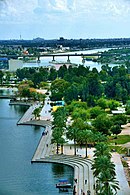Haydar-Khana
Haydar-Khana محلة الحيدرخانة | |
|---|---|
Neighborhood | |
 | |
| Country | Iraq |
| Governorate | Baghdad Governorate |
| First settled | Abbasid Caliphate |
| Time zone | UTC+3 |
Haydar-Khana (Arabic: محلة الحيدرخانة) is an old locality and neighborhood located in Baghdad, Iraq. Located at the beginning of al-Rasheed Street and near al-Maidan Square, it's one of the oldest localities in Baghdad which dates back to the Abbasid Caliphate. The locality was also home to many personalities of Iraq such as Iraqi artist Nazem al-Ghazali and former-Iraqi Prime Minister Nuri al-Said.[1][2]
Biography[edit]
The locality has been settled as far back as the Abbasid Caliphate.[1] The word "Khana" means "settlement" in the Arabic language while the origins of the name "Haydar" is disputed. The name is attributed to a Sufi man who went by the name of "Haydar" whose history is unknown,[3] although it was later attributed to Haydar Pasha Jalabi Shabandar, an Iraqi notable who established Hammam Haydar in the locality in 1650 and is buried in the same place along with some members of his family. Although no there's no historical connection between Shabandar and the locality's name.[1][4]
One of the most notable landmarks of the locality is the Haydar-Khana Mosque, located between the locality and al-Rasheed Street, the Mosque dates back to the reign of Abbasid Caliph al-Nasir and later renovated by Dawud Pasha, the last Mamluk governor of Baghdad in 1827 where a Madrasa was established inside of it. In 1920, the notables of Baghdad would gather in the mosque which kickstarted the Iraqi Revolt against British colonialism of Iraq. It was nicknamed by Iraqis the "Revolution Mosque."[3] The Mosque witnessed many arrests by British forces, as it was a major center for the uprisings that were launched from al-Rasheed Street.[1]
Despite the locality being one of the poorest neighborhoods in Baghdad, it was the home of many prominent Iraqi personalities and poets such as the artist Nazem al-Ghazali and poets such as Jamil Sidqi al-Zahawi. Poets recited poems in the Haydar-Khana Mosque and Iraqi Jews lived in the locality and had an influence in the area for a while.[2] It's also home to the oldest families in Baghdad. Cafés such as al-Zahawi Café and Hassan Ajami Café in the locality were widespread and became havens for artists, writers, poets, and intellectuals.[1][5]
The locality currently suffers from neglect and its narrow alleyways and roads are filled up with rubbish. A lot of the apartments have also been abandoned and parts have been turned into warehouses. It is also bordered by al-Jumhuriya Street.[4]
Notable landmarks[edit]
Al-Aqoli Mosque[edit]
Al-Aqoli Mosque (Arabic: جامع العاقولي) is one of the oldest mosques in Baghdad and was built in 1327. The mosque is characterized by several domes connected to each other, and the domes rest on four columns of brown alabaster, in addition to the domes resting on the surrounding walls.[6]
Haydar-Khana Mosque[edit]
Haydar-Khana Mosque (Arabic: جامع الحيدر خانة) is the most well-known landmark in the locality. The mosque represents a great historical and revolutionary symbol for Iraqis as it enjoyed the gathering of many demonstrations against British forces. The mosque includes a number of Madrasa for teaching Islamic sciences, and a library containing works by the most prominent scholars of the country. Due to its age, it was also a tourist attraction.[7]
Home of Nazem al-Ghazali[edit]
One of the most well-known areas of the locality among its locals is the home of artist Nazam al-Ghazali.[4]
References[edit]
- ^ a b c d e "الگاردينيا - مجلة ثقافية عامة - محلة وجامع الحيدرخانة مهد انتفاضات ورموز شامخة". 2018-08-20. Archived from the original on 2018-08-20. Retrieved 2023-07-09.
- ^ a b الكويتية, جريدة الجريدة (2023-03-23). "ناظم الغزالي... صوت العراق وسفير أغنيته "1-6"". جريدة الجريدة الكويتية (in Arabic). Retrieved 2023-07-09.
- ^ a b "الحيدر خانة تتكسر معالمه ووزارة الثقافة تعلّق بإحباط على إعمار محتضن قادة ثورة العشرين! » وكالة بغداد اليوم الاخبارية". وكالة بغداد اليوم الاخبارية (in Arabic). Retrieved 2023-07-09.
- ^ a b c "الحيدر خانة.. مختلف في تسميتها ومتفق على روعة تراثها". مجلة الشبكة العراقية,IMN Magazine (in Arabic). 2017-10-29. Retrieved 2023-07-09.
- ^ "حسن عجمي .. مقهى الأدباء الذين غابوا عن حضور مئويته!". مجلة الشبكة العراقية,IMN Magazine (in Arabic). 2017-12-05. Retrieved 2023-07-09.
- ^ History of Baghdad Mosques and their Antiquities - Authored by Mahmoud Shukri Al-Alusi
- ^ "الحيدر خانة.. ذاكرة دينية ورمزية سياسية بالعراق". www.aljazeera.net (in Arabic). Retrieved 2023-07-09.


 French
French Deutsch
Deutsch